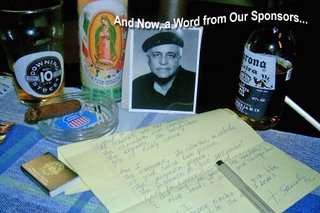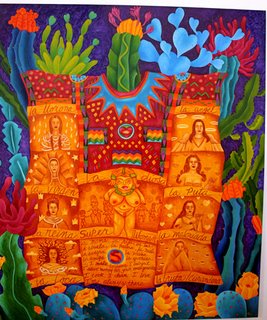
September 16, 2006
Just before dawn on September 16, 1810 Miguel Hildalgo y Costilla (better known as Padre Hidalgo) rang the church bell in village of Dolores and called the indigenous community to war against the Spanish. His historic cry of "Mexicanos, Viva México!" signaled the beginning of the war for independance and is known as El Grito de Dolores. Every year on September 15th, the President of Mexico gives the Grito but this year, with the furor over the election it was a very near thing. They actually considered not doing it. But I'm not here to talk about the elections. I only bring it up because it's a beautiful and important tradition. (For more on that, see Luis J. Rodriguez' excellent blog at Xispas.com).
Tradition is important to me. In my family when my grandparents were alive, we followed our traditions with great anticipation. We were proud of them. Care was taken. Everything had deep meaning and there was a reverence about it. When they died the family fell apart and the traditions that I grew up with died too. I became the only one left that clung to the old traditions.
To me they became more sacred, my personal Holy Grail. I resurrected them, added to them, researched them and made a new family made up of friends, neighbors and co-workers to share them with. In doing this, my old family traditions became new again and glowed with a new light.
The September 16th El Grito party is one of the traditions that I’ve kept alive and saved for my children. It used to be a big deal for my grandparents. We’d spend days making paper flowers, confetti in green, white and red, a homemade piñata and cooking all the special, traditional foods. My grandmother’s sisters and cousins would come over and we’d all cook and tell stories as we worked together cooking, baking and singing. I remember baking my first bandera cake made with Duncan Hines yellow cake mix, canned frosting dyed red, white and green with food coloring and an eagle made of broken lifesavers. I was eight and I’ll never forget my grandfather’s face and how proud he was when he saw it. I remember he would get teary-eyed over the bandera. It meant that much to him.
Well things have changed. I haven’t used a box cake mix since I was ten. My recipes have gotten more traditional, more elaborate and I go out of my way to find old recipes that are almost forgotten. I get a kick out of bringing the old into the light. I’d like to take my post time this week to invite you, my La Bloga family to this year’s celebration of El Grito, held in a little pink house in Eagle Rock, Califas. You’re Mexicanos for the day y nuestro casa es tu casa. Bienvenidos!

On this year's menu: Mole con pollo, rajas con queso y crema, chiles en nogada, nopale salad, chips, salsa, guacamole, taquitos, stewed apples with goat milk cajeta and guayaba, arroz con leche, melon, margaritas de orchata de melon, tequila, cervecita, sangria, arroz bandera (white, red and green rice), frijoles borrachos, enchiladas Sarita (made with squash flowers, tomato, onions, cheese and cream) y una piña rellenado.

Too many Margaritas, Chris?

What would I do without my best amiga y comadre Elodia? Aren't mother and daughter beautiful?
 Mara Price, illustrator; Mary Wynton, our Eagle Rock librarian (hey authors, Mary's trying to get a Chicano author series going for Eagle Rock library so swing by and help her out. The library can't pay but they sure can publicize. Be down for the community and the public library!) and Rene Colato, author of children's books like Loteria! (he devoted his September 16th to teach the kids at Eagle Rock Public Library how to play loteria. How cool is that?).
Mara Price, illustrator; Mary Wynton, our Eagle Rock librarian (hey authors, Mary's trying to get a Chicano author series going for Eagle Rock library so swing by and help her out. The library can't pay but they sure can publicize. Be down for the community and the public library!) and Rene Colato, author of children's books like Loteria! (he devoted his September 16th to teach the kids at Eagle Rock Public Library how to play loteria. How cool is that?).

PEDRO INFANTE!!! Yeah, baby we watch Pedro Infante movies on September 16th. What's a Mexican party without Pedro Infante? Who can tell me what movie this is? I bet Denise Chavez can.
And speaking of Pedro Infante....

Sol y Victor acting silly as we hang the lights
Read: 1) my La Bloga review of Loving Pedro Infante and 2) Loving Pedro Infante
He's a papi chulo though, nice and a hell of a lot of fun.
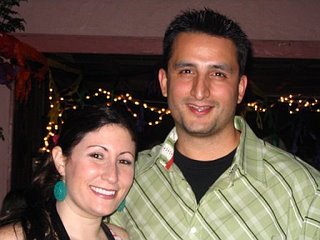
And then there's my roommate Rachel with Jerry from Jerry's Mexican Grill. Jerry and Kiko kicked us down with everything from chafing dishes and chiles to guacamole and taquitos. The taquitos there are damned good! Feel like some good cooking and can't get to Sol's house? Head on down to Jerry and tell him Rachel and Gina sent you. They have two locations now because they're so good. Nice people too.
Eagle Rock Location
4923 Eagle Rock Blvd.
(2 blocks south of Colorado Blvd in the CVS Shopping Center)
323-257-8815Santee Food Court716 F South Los Angeles Street(7th and Los Angeles)213-624-TACO

Kiko is a sweetheart! Y caramba!!! El vato can sing!!! When you're down at Jerry's ask Kiko to sing you El Rey. Oh yeah and he was one of the very few at the party that knew all the words to the Mexican National Anthem!!!
Do you?
Mexicanos, al grito de guerra
El acero aprestad y el bridón;
y retiemble en sus centros la tierra Al sonoro rugir del cañón.
Ciña oh patria!
tus sienes de oliva
De la Paz el arcángel divino,
Que en el cielo tu eterno destino
Por el dedo de Dios se escribió.
Más si osare un extraño enemigo
Profanar con su planta tu suelo,
Piensa, oh patria querida, que el cielo
Un soldado en cada hijo te dio.
Guerra, guerra sin tregua al que intente
De la patria manchar los blasones!
Guerra, guerra! Los patrios pendones. En las olas de sangre empapad.
Guerra, guerra! En el monte, en el valle Los cañones horrísonos truenen
Y los ecos sonoros resuenen Con las voces de Unión!Libertad!
Antes, patria,que inermes tus hijos
Bajo el yugo su cuello dobleguen,
Tus campiñas con sangre se rieguen, Sobre sangre se estampe su pie.
Y tus templos, palacios y torres Se derrumben con hórrido estruendo,
Y sus ruinas existan diciendo:De mil héroesla patria aquí fuePatria! patria!
Tus hijos te juran
Exhalar en tus aras su aliento,
Si el clarín con su bélico acento
Los convocaa lidiar con valor.
Para ti las guirnaldas de oliva!
Un recuerdo para ellos de gloria!
Un laurel para ti de victoria!
Un sepulcro para ellos de honor!
heroes.
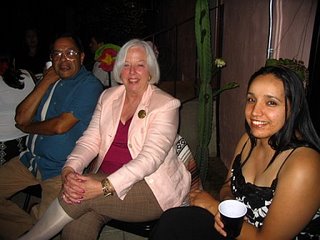
Sedano is off the hook on that one, he left before the mariachi came over. There he is hanging with his lovely wife Barbara and Rachel's friend Johanna.
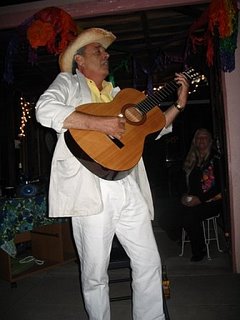
Isn't it cool to have a mariachi next door? He took requests too and sang a lovely duet with Rachel.
His name is Gus and he and Kiko seriously kicked some musical butt!
El Rey, Volver y Volver, Tu Solo Tu, Las Mananitas for Johanna who's birthday is this week and a few other amazing ballads to finish off the night.
Check out Sarah in the background listening. Sarah is editor in chief of AWN.com, an online publication dedicated to serving the animation community. The guy with wings belongs to her.

All nights should end in baladas, laughter and the scent of night earth and flowers.

Rene won the hula hoop competition!
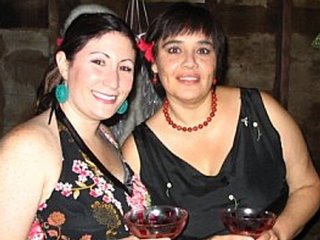
We hope you enjoyed the party. As always, I invite your comments. What traditions do you treasure? Which ones have fallen by the wayside and how can we resurrect them? How did you spend your September 16th? A comment might get you an invitation to the next party.
Hasta la proxima,
Gina MarySol Ruiz y amigos















 David Hernandez
David Hernandez